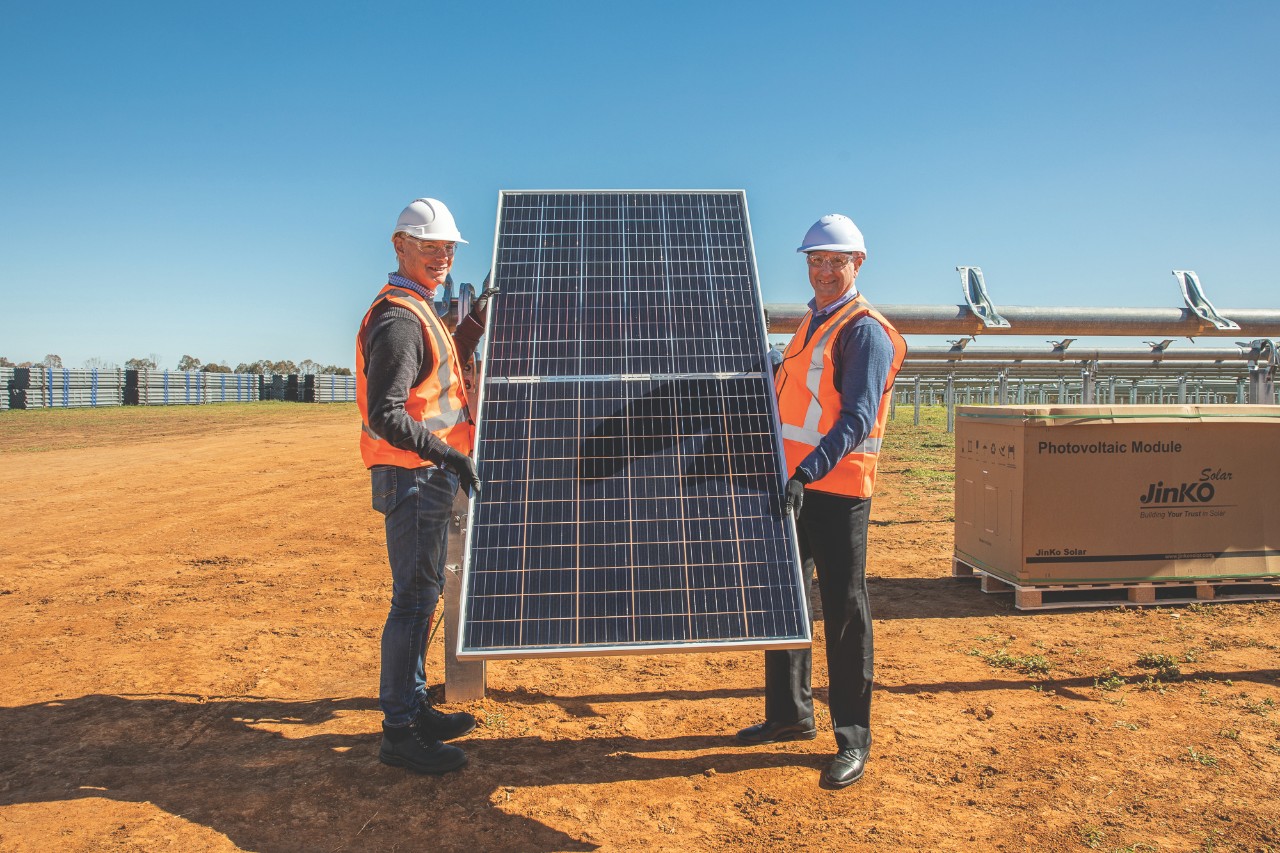- publish
A verification email has been sent.
Thank you for registering.
An email containing a verification link has been sent to .
Please check your inbox.
An account with your email already exists.
Case study: Bright spark
Listed@ASX Summer 2020/2021
Spark Infrastructure ASX:SKI
The energy infrastructure company has challenged the markets with its move into unregulated assets.

Spark MD Rick Francis (left) and chair Doug McTaggart (right) at the ceremony to install the first bi-facial solar panel of 310,000 solar panels for its Bomen solar farm in Wagga Wagga
Spark Infrastructure (ASX:SKI) shareholders love the stock it for its investments in regulated energy assets that deliver steady returns and strong yield, which is particularly appealing in this uncertain COVID-19 environment.
But the company has been adding unregulated renewable energy assets to its investment mix, a move that has raised investor questions and triggered an investor relations challenge.
“Investors like Spark because it is a nice secure investment they could put in their desk draw and not have to worry about,” says managing director, Rick Francis. “But we had to get them to think differently about the industry and our business.”
Since 2005, Spark has built a portfolio of regulated assets largely focused on companies that distribute and transmit energy, including Victoria Power Networks and SA Power Networks.
But the successful bid in 2015 for NSW transmission business Transgrid, that saw Spark emerge with a 15 per cent stake, represented a turning point for the company.
Francis says it became clear it wasn’t going to be business as usual in the energy industry. It wasn’t going to remain in a steady growth phase, but benefit from the tailwind of accelerating electrification of the economy. It also had a vital role in the push to renewables and lower emissions.
Francis says Spark wanted to be at the forefront of those revolutions. The company could support lower emissions by using its infrastructure to efficiently connect and move renewable energy around the national market.
But Spark also decided to invest directly in underlying renewable energy generation. It now has an additional clear goal: to build a platform of contracted renewable assets – including wind, solar and storage – potentially totalling one gigawatt of electricity generation valued at around $1 billion.
Its first renewables investment was the acquisition in April 2019 of the Bomen Solar Farm project near Wagga Wagga in New South Wales, which it has now built and commissioned successfully.
While the renewables investments will represent less than 15 per cent of its total asset base, Spark’s push did create uncertainty among shareholders. “People invest in the business because of the long-term secure and robust regulatory framework that prevails over our assets,” Francis says. “Any change comes with question marks.”
So, Spark built a narrative to tell shareholders. It said the renewables push would not compromise the strength and qualities of existing assets. It also said Spark’s renewables investments were a natural, gradual outreach into an adjacent asset class.
Spark provided further comfort to shareholders by emphasising it won’t be exposed to energy price volatility. Its renewable assets will have long-term contracts. The Bomen Solar Farm has lengthy contracts to sell energy to Westpac and Flow Power. Some 95 per cent of its output is contracted for the first five years, and 82 per cent has been contracted in total over the first ten years.
Execution has been a question mark hanging over renewables. But Francis says Spark is now getting kudos from investors for successfully completing the construction of Bomen on time and under budget. “We’ve demonstrated we know what we are doing.”
If Spark hits certain targets, the company could generate compound growth in its asset base of more than six per cent a year over the next four years. That’s well above previous compound growth of 1.5 per cent to two per cent a year.
So far, existing investors have responded well. “We haven’t scared off any shareholders; we haven’t seen any fundamental shift in terms of our major shareholders or register composition.”
The key to Spark’s investor relations strategy around renewables has been about a clear and consistent story, Francis says. “Investors have a short amount of time to think about you. They are also risk averse, particularly in our industry. It’s taken us years to get to this point. It’s a journey. It’s about increasing the amount of time you have in front of investors, getting clear on the story, and above all being consistent in the repetition of your story.”
Related links
Subscribe to Listed@ASX
Download the “Listed@ASX” app - available from the Apple App Store and Google Play - or email listed@asx.com.au to request a hard copy of the magazine.
About the author

Ben Power, Freelance finance writer
Ben Power is a finance, economics and business writer. He has covered investments and corporate activity at leading titles including The Australian Financial Review, Bloomberg, The Sydney Morning Herald and Investors Chronicle magazine.
About Listed@ASX magazine
ASX’s bi-annual Listed@ASX magazine covers listed company best practice and issues of interest. With professional journalism and a subscription list covering directors, CEOs, senior executives, company secretaries and advisers of listed companies it is a must-read for members of the ASX listed community.